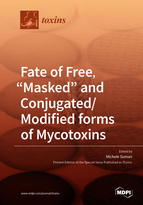Fate of Free, “Masked” and Conjugated/Modified forms of Mycotoxins
A special issue of Toxins (ISSN 2072-6651). This special issue belongs to the section "Mycotoxins".
Deadline for manuscript submissions: closed (31 January 2020) | Viewed by 43277
Special Issue Editor
Special Issue Information
Dear Colleagues,
Mycotoxins are fungal metabolites commonly occurring in food, which pose a health risk to the consumer. In the last few years, worldwide authorities have frequently expressed opinions, setting limits, regulations and guidelines in order to reduce their levels in raw materials and food commodities. Modified forms of mycotoxins are often called “masked”. Masked mycotoxins, in ”senso strictu”, are conjugates of mycotoxins resulting from metabolic pathways activated by the interplay between pathogenic fungi and infected plants. Free mycotoxins can therefore frequently occur along with their conjugated forms.
Chemical and toxicological fate of mycotoxins is significantly related also to food processing, which implies high temperature, additives/improvers, long processing time, fermentation, etc. For example, this can then determine the release of parent compounds from/to conjugated forms as well as the ‘masking’ phenomenon associated with the mechanical energy and heat generated, which can prompt reactions with organic macromolecules. Thus, it is fundamental to develop proper analytical methods able to quantify all the different forms in both raw materials and finished food products; beside this it is crucial to assess human/animal exposure to modified forms of the various toxin forms in addition to the parent compounds, because many modified forms are hydrolyzed into the parent compounds or released from the matrix during digestion.
The present Toxins Special Issue will deal with all the different multi-faceted issues of this complex scenario.
Dr. Michele Suman
Guest Editor
Manuscript Submission Information
Manuscripts should be submitted online at www.mdpi.com by registering and logging in to this website. Once you are registered, click here to go to the submission form. Manuscripts can be submitted until the deadline. All submissions that pass pre-check are peer-reviewed. Accepted papers will be published continuously in the journal (as soon as accepted) and will be listed together on the special issue website. Research articles, review articles as well as short communications are invited. For planned papers, a title and short abstract (about 100 words) can be sent to the Editorial Office for announcement on this website.
Submitted manuscripts should not have been published previously, nor be under consideration for publication elsewhere (except conference proceedings papers). All manuscripts are thoroughly refereed through a double-blind peer-review process. A guide for authors and other relevant information for submission of manuscripts is available on the Instructions for Authors page. Toxins is an international peer-reviewed open access monthly journal published by MDPI.
Please visit the Instructions for Authors page before submitting a manuscript. The Article Processing Charge (APC) for publication in this open access journal is 2700 CHF (Swiss Francs). Submitted papers should be well formatted and use good English. Authors may use MDPI's English editing service prior to publication or during author revisions.
Keywords
- mycotoxins
- masked mycotoxins
- modified mycotoxins
- conjugated mycotoxins
- chemical fate
- toxicological fate
- food processing
- raw materials
- food commodities
- analytical methods







